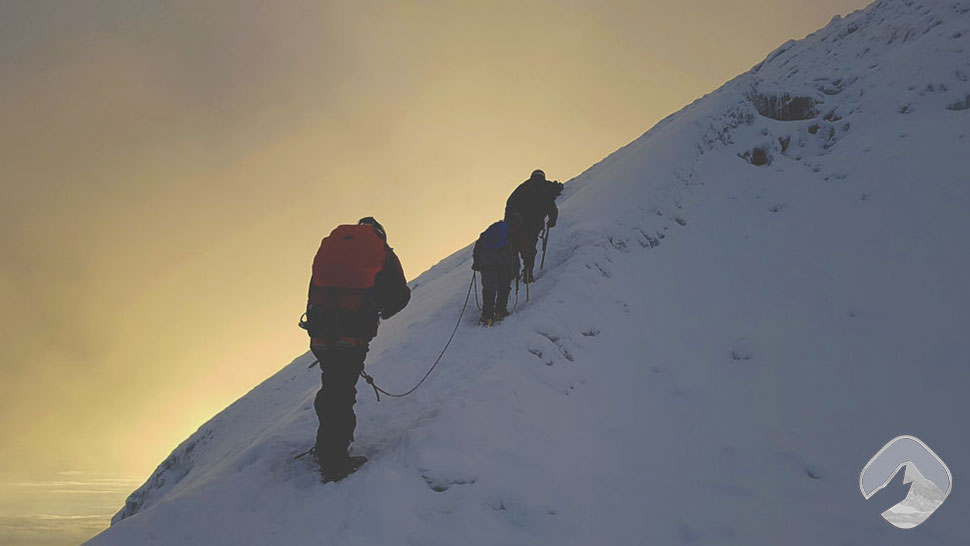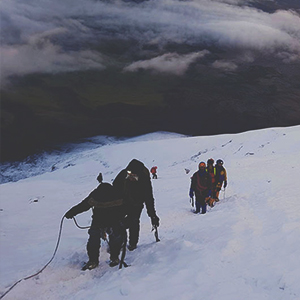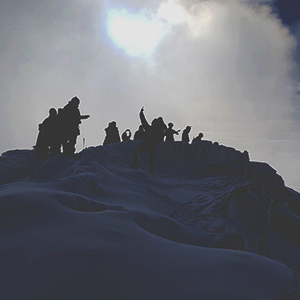Climb Cotopaxi Volcano Ecuador
This program concentrates on Climb Cotopaxi Volcano Ecuador. The Cotopaxi 5,897 m. (19,347 ft.) is the second-highest mountain in Ecuador and one of the highest active volcanoes in the world. While active, it is the most frequently climbed mountain in the country and one of the most visited peaks in South America. We recommend this program for guests that have good previous acclimatization in Ecuador.
Ecuador’s Must Climb Volcano
The summit or highest point it’s actually the northern rim of the crater, which is rounded and measures approximately 480 meters wide. The smell of sulfur and the presence of fumaroles are evident from up there. A circuit of its inner crater rim can be done in about one and a half hours depending on snow conditions. Several visits into the crater have been undertaken, most of them by Ecuadorian parties.
Cotopaxi Volcano is a perfectly symmetrical cone, covered in a thick blanket of snow and ice, gracefully rises from a beautiful paramo plateau. The climb up to the summit of Cotopaxi is not highly technical, but it does require a pre-climb glacier travel course. You will take part in such a course the afternoon before the Climb Cotopaxi Volcano Ecuador. The course includes the use of crampons, ice axes and ropes. Leaving from the refuge around midnight climbers begin the ascent of the volcano arriving at the top of Cotopaxi after sunrise at 6-7 AM.
5 Amazing Facts about Cotopaxi Volcano
Summiting this monstrosity of nature is no small feat! For the experienced mountain climbers among you, a summit to the peak of Cotopaxi Volcano is a once in a lifetime activity you should do while visiting the area.
- Alexander von Humboldt was the first European to attempt an ascent of Mount Cotopaxi.
- Since 1738, Mount Cotopaxi has erupted more than fifty times. The most violent eruptions took place in 1744, 1768, 1877 and 1904. The last, but minor one, in 2015.
- Cotopaxi’s steep cone has nested summit craters, the outer of which measures 550 x 800 m in diameter.
- Cotopaxi is one of South America’s most famous volcanoes and one of its most active ones.
- Every weekend, approximately 100 people attempt to climb the summit of this volcano.
Safety and Guides
Our guides have all of the necessary safety accreditations as well as hundreds of hours of experience climbing Ecuador’s two most popular peaks Chimborazo and Cotopaxi.
If you didn’t know it, Mount Cotopaxi is one of the three highest active volcanoes in the world, last erupting in the 1940s, and is one of Ecuador’s most active volcanoes. The climb to the summit is strenuous, but for those who successfully reach the top, amazing views of the crater and incredible sunrise views of the surrounding region are part of the reward. You can also check our other available Volcanoes Summits in Ecuador.
Climb Cotopaxi Volcano Ecuador
Latacunga to Refugee
13:00 Departure from Latacunga and lunch on the way, arrival at the Cotopaxi National Park
15:00 Arrival at the control of the National Park for the corresponding registration, then we will continue to visit the museum and interpretation centre “Mariscal Sucre” where you will appreciate the flora and fauna existing in the park
16:00 Arrival at the parking lot of the volcano (4500 m.s.), from where the walk to the refuge will start (40 minutes to 1 hour).
17:00 Arrival at the José Rivas refuge (4800 m.s.m.), rest.
19:00 Dinner
Summit and back to Latacunga
00:00 Departure to the summit of the volcano
07:00 Arrival at the summit (5897 m.s.n.m)
10:00 Return to the shelter to order and collect all the equipment
11:00 Departure from the parking lot to the city of Latacunga
13:00 Arrival to the city of Latacunga. End of the Tour
Prices:
From 2 people - US$ 295 /person
4 to 6 people - US$ 275 /person
Ask us for our special group prices
Climbing details:
Difficulty: Hard
Range of Altitude: 4'600 to 5'897 m. / 14'763 to 19'347 ft.
Distance Covered: Approx. 7,8 km. / 4,8 miles
Included:
Transportation Latacunga - Cotopaxi - Latacunga
Meals during the Tour (L/D/B)
Accommodation in the Refuge
Climbing Equipment
Professional Guide
Not Included:
Transportation from Quito (+$45pp)
Personal Insurance
Warm climbing clothes
Extra food, Snacks, Energy drinks
Tips and Beverages









